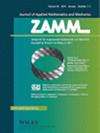初始非直线梁的静力凝结
IF 3.2
4区 工程技术
Q1 MATHEMATICS, APPLIED
Zamm-zeitschrift Fur Angewandte Mathematik Und Mechanik
Pub Date : 2023-10-25
DOI:10.1002/zamm.202300668
引用次数: 0
摘要
摘要进一步研究了文献中常用的两个弱非线性积分运动方程,分别用于研究直欧拉-伯努利梁和初非直欧拉-伯努利梁的非线性动力学。注意力集中在被称为“静态凝结”的过程上,它包括在精确的、完全非线性的运动方程系统中忽略轴向惯性,以确定轴向位移作为横向位移的函数。本文的新颖之处在于,除了一个非常特殊和特殊的情况外,它表明,与期望相反,并且在某种程度上令人惊讶的是,具有非直线初始构型的梁的积分方程不能通过从精确的,完全非线性的运动方程开始的静态凝聚过程得到。相反,证实了众所周知的结果,即对于直线梁,可以通过静力凝聚得到积分方程。这突出了两个积分方程在可靠性方面的主要区别,并使我们能够更好地理解直线梁的积分方程,其背后的数学背景比非直线梁的经典对立物更强(即,它可以从精确的、完全非线性的、通过静态凝聚的运动方程中获得),这为它提供了一个“特殊”的行为,使它更值得信赖。本文章由计算机程序翻译,如有差异,请以英文原文为准。
On the static condensation of initially not rectilinear beams
Abstract Two weakly nonlinear integral equations of motion commonly used in the literature to study the nonlinear dynamics of straight and initially not rectilinear Euler‐Bernoulli beams, respectively, are further investigated. Attention is focused on the process known as “static condensation”, which consists of neglecting the axial inertia in the exact, fully nonlinear system of equations of motion to determine the axial displacement as a function of the transversal one. The novelty of the paper relies on showing that, contrarily to expectation and somehow surprisingly, the integral equation for beams with a not rectilinear initial configuration cannot be obtained by the static condensation process starting from the exact, fully nonlinear, equations of motion, apart from a very particular and specific case. On the contrary, it is confirmed the well‐known result that for rectilinear beams the integral equation can be obtained by the static condensation. This highlights a major difference between the two integral equations in terms of reliability and allows us a better understanding of the integral equation of rectilinear beams, underlying its stronger mathematical background than the classical counterpart for not straight beams (i.e., its being obtainable from the exact, fully nonlinear, equations of motion via static condensation), which provides it with a “special” behavior and makes it more trustworthy.
求助全文
通过发布文献求助,成功后即可免费获取论文全文。
去求助
来源期刊
CiteScore
3.30
自引率
8.70%
发文量
199
审稿时长
3.0 months
期刊介绍:
ZAMM is one of the oldest journals in the field of applied mathematics and mechanics and is read by scientists all over the world. The aim and scope of ZAMM is the publication of new results and review articles and information on applied mathematics (mainly numerical mathematics and various applications of analysis, in particular numerical aspects of differential and integral equations), on the entire field of theoretical and applied mechanics (solid mechanics, fluid mechanics, thermodynamics). ZAMM is also open to essential contributions on mathematics in industrial applications.

 求助内容:
求助内容: 应助结果提醒方式:
应助结果提醒方式:


